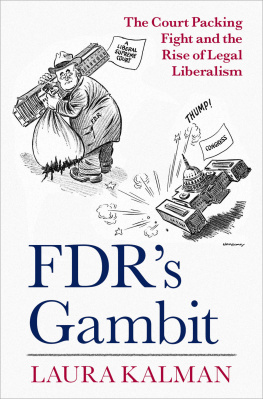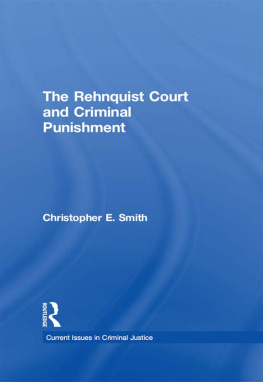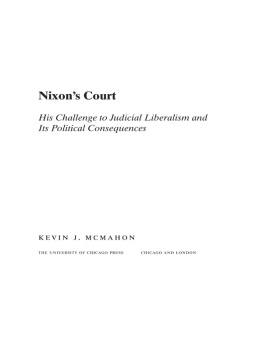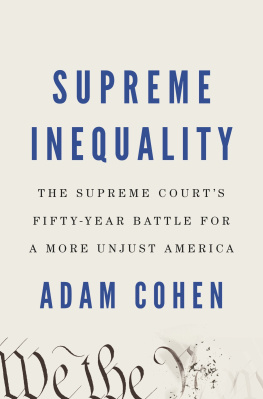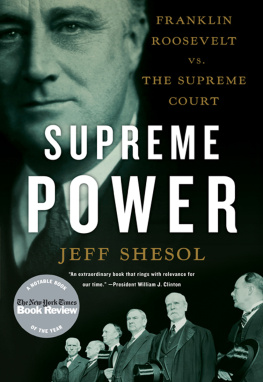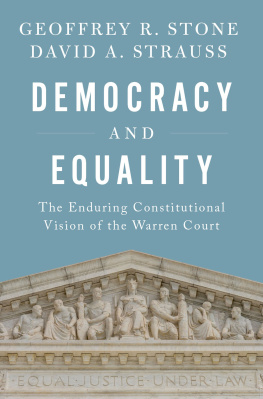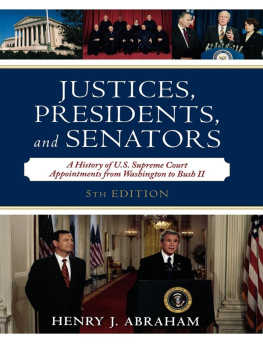The Long Reach of the Sixties

Oxford University Press is a department of the University of Oxford. It furthers the Universitys objective of excellence in research, scholarship, and education by publishing worldwide. Oxford is a registered trade mark of Oxford University Press in the UK and certain other countries.
Published in the United States of America by Oxford University Press
198 Madison Avenue, New York, NY 10016, United States of America.
Oxford University Press 2017
All rights reserved. No part of this publication may be reproduced, stored in a retrieval system, or transmitted, in any form or by any means, without the prior permission in writing of Oxford University Press, or as expressly permitted by law, by license, or under terms agreed with the appropriate reproduction rights organization. Inquiries concerning reproduction outside the scope of the above should be sent to the Rights Department, Oxford University Press, at the address above.
You must not circulate this work in any other form and you must impose this same condition on any acquirer.
Library of Congress Cataloging-in-Publication Data
Names: Kalman, Laura, 1955 author.
Title: The long reach of the Sixties : LBJ, Nixon, and the making of the contemporary Supreme Court / Laura Kalman.
Description: New York, NY : Oxford University Press, 2017.
Identifiers: LCCN 2016036598 | ISBN 9780199958221 (hardback) | eISBN 9780199967773
Subjects: LCSH: United States. Supreme CourtOfficials and employeesSelection and appointmentHistory20th century. | JudgesSelection and appointmentUnited StatesHistory20th century. | United StatesPolitics and government19631969. | United StatesPolitics and government19691974. | BISAC: HISTORY / United States / 20th Century. | LAW / Legal History.
Classification: LCC KF8742 .K35 2017 | DDC 347.73/2634dc23
LC record available at https://lccn.loc.gov/2016036598
In Memory of
Newton Kalman, 19202010
Celeste Garr, 19242010
John Morton Blum, 19212011
Lee Kalman, 19192014
Protectors, Promoters, Teachers, Friends
CONTENTS
Five weeks later, Obama nevertheless nominated Merrick Garland, a white Harvard College and Law School alumnus. Like almost all justices since the mid-1970s, Garland was a federal judge with sterling credentials. He had been articles editor of the Harvard Law Review and had clerked for two legendary judges, Henry Friendly and William Brennan. He had also served as a partner in one of the capitals preeminent law firms, federal prosecutor in the Bush I administration, and deputy assistant attorney general in the Clinton administration before Clinton successfully named him to the DC Circuit Court of Appeals. By some standards Garland was centrist; by others, he was a centrist liberal slightly to the right of the courts liberals. While he was the best the Republicans could hope for, a Justice Garland seemed likely to move the court leftward. Senate Republicans simply refused to hold hearings.
The Long Reach of the Sixties shows how, between 1965 and 1971, Supreme Court nominees and their confirmations became critical to presidential politics. As Lyndon Johnson and Richard Nixon, the Senate, prospective justices, members of the court, interest groups, and the public mobilized, they created and politicized the modern nomination and confirmation process. The period saw two successful Supreme Court nominations and two failed ones by Johnson, and four successful Supreme Court nominations and two failed ones by Nixon. The quest to enlist the court in consolidating presidential power provoked clashes that had lasting consequences for the courts political significance and the selection and confirmation of Supreme Court justices that still resonate today.
Scholars have long focused on the turning point that Roosevelts 1937 court-packing plan posed for president, court, and country. After the resolution of that crisis, however, the court and its membership consumed space in presidents partisan calculations only sporadically. FDR wasted little time worrying about the Senates reaction to his prospective Supreme Court nominees or what they would do as justiceswhich may be one reason they fought with each other so much. That pattern continued under Truman, Eisenhower, and Kennedy.
Then, when LBJ and Nixon in rapid succession tried to enlist the court in service of their presidencies, the Senate asserted itself and nominations became controversial. Just as we evaluate the impact of presidential nominees on the court, we need to examine prospective justices in the context of the presidency. As Johnson and Nixon saw it, they needed a clearer idea of what potential candidates for court vacancies would do because the Supreme Court under Earl Warren was making waves by transforming the meaning of the Constitution for civil rights, criminal procedure, internal security, reapportionment, religion, and speech. With their expansive vision of the political chessboard and potential chess pieces, LBJ and Nixon modeled for their successors how the president should and should not factor the court into the politics of the presidency.
With his first nomination, Johnson sought to install a spy at the Supreme Court, to maintain the tradition of the Jewish seat, and to continue keeping
The Warren Court became Richard Nixons quarry. He used it to win election in 1968 and to unify, shape, and broaden the modern Republican Party. As president, he tried to create vacancies by getting rid of two of the courts most liberal members. He also nominated six individuals to the Supreme Court whom he touted as strict constructionists or constitutionalists who would roll back the work of the Warren Court. Now, liberal Democrats, often aided by moderate or progressive Republicans, mounted a counterattack.
The Long Reach of the Sixties turns the spotlight on Johnsons and Nixons attempts to populate the court between 1965 and 1971. Using recordings of presidential telephone conversations, along with archival sources, it grounds the efforts by LBJ and Nixon to shape the court in the political history of their presidencies. It places the ideological contest over the court within the context of the struggle between the executive, judicial, and legislative branches of government, as well as interest group mobilization. The fights that followed fixed the image of the Warren Court as activist and liberal in one of the arenas where that image matters most, the contemporary Supreme Court appointments process.
The book also investigates the ways in which the sixties, a period that lasted into the early seventies, have haunted and scarred that process. Of course, Supreme Court nominees had faced attack before the late Warren era. But even by the standards of the nineteenth century, when confirmation struggles over Supreme Court justices routinely occurred, the fights about nominees from 1967 to 1971 proved exceptionally contentious. If how we react to a Supreme Court nominee depends on whose ox is gored, what makes this period special is that Warren Court partisans and antagonists alike had plenty of oxen at risk for slaughter.
We improve our understanding of the combination of political and constitutional developments that have made so many nominations since the mid-twentieth century so significant if we root the modern Supreme Court appointments process in the sixties. But we should recognize that just as contingency pervades history, it plays a large role in this story. Like other presidents, LBJ and Nixon named people to the Supreme Court according to Holmess proverbial felt necessities of the time, and, as ever, all history teaches us is that history turns on a dime. If political science is too neat to instruct Americans on how to govern, history is too messy.


